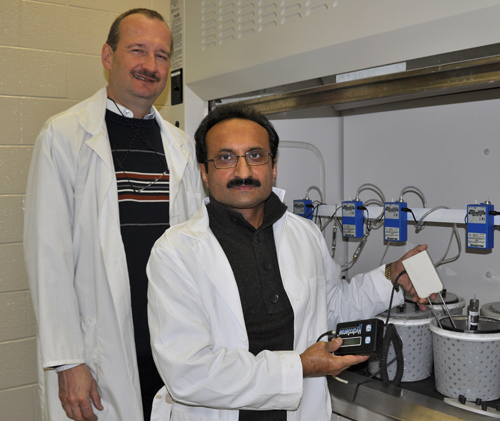
When a gas station closes, it’s often necessary to remove contaminated soil before the site can be redeveloped. Guelph researchers in the School of Engineering are looking for a way to clean rather than remove gasoline-laden soil and see promise in a form of bacteria that actually feed on the toxic substance.
Soil contaminated with gasoline, also known as petroleum hydrocarbon, poses a number of environmental and safety risks. Gasoline vapours cause air pollution, and if the vapours seep into a building’s basement, a spark can cause an explosion. One unit of gasoline can contaminate one million units of water.
“My objective is to clean the soil because if the soil is clean, it helps keep the groundwater clean,” says Prof. Richard Zytner, School of Engineering.
One way to remediate gasoline-contaminated soil is to drill wells into the ground and extract the vapour. This method, known as soil vapour extraction, has been used for several decades, but it has its limitations.
“There is a point where it is no longer efficient or effective to continually apply the vacuum,” says Zytner. “It’s not efficient for the energy expended.”
Another option, called bioventing or biostimulation, involves bacteria that are naturally found in the soil. These bacteria, called hydrocarbon degraders, feed on gasoline, but they need other nutrients like nitrogen to do their job.
Zytner’s research is looking at how to maximize the bioventing process. The bacteria’s efficiency depends on the type of soil they need to clean.
“The challenge is predicting how fast the gasoline will be degraded, which varies from site to site,” says Zytner.
Previous U of G research has involved 200 grams of soil, but a gasoline-contaminated site could contain several hundred tons. Zytner’s PhD student, Alamgir Khan, is using four kilograms of soil in his research, and the results indicate that the larger the soil sample, the smaller the degradation rate.
“Working with soil is expensive and challenging in the lab,” says Zytner. “Soil is one of the most difficult matrices to work with.” He hopes to study up to 80 kilograms of soil in his future research.
Bioventing is a slower process than soil vapour extraction, but it’s less costly. “When you slow down the rate of air pumping, it provides enough oxygen to keep the bioventing microorganisms happy, provided there are sufficient nutrients,” says Zytner. “One of the things that’s important for us to know is when do you shut off the soil vapour extraction and go to bioventing.”
If gasoline-contaminated soil is left untreated, nature will eventually take its course and clean up the site. Biostimulation gives nature a helping hand.
Stimulating the bacteria that live in the soil is more effective than growing bacteria in the lab and injecting them into the ground because they’re already accustomed to their environment.
“They’re already living there,” says Zytner. “They might not be that active, but once they get the food, the hydrocarbon, and you give them oxygen and nutrients, they go to work.”